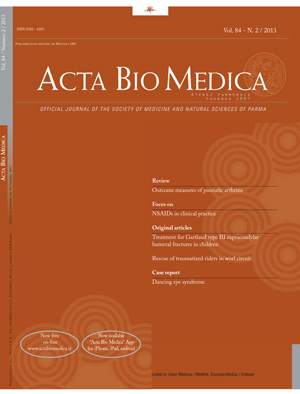Are there any strategies to improve neonatal outcomes associated with epidural analgesia in labor?
Keywords:
Epidural analgesia, labor, newborn, body temperature, breastfeeding, deliveryAbstract
Background and aim of the work: This study was aimed at evaluating the relationship between epidural analgesia and perinatal outcomes and at verifying the advisability of procedural changes in assistance to labor.
Subjects and methods: From January to December 2012, we conducted a retrospective case-control study on 1,963 laboring pregnant women admitted to the Parma University Hospital. We considered two groups: Group 1 received epidural analgesia and Group 2 received no analgesia. Women with elective cesarean sections, multiple pregnancies or deliveries at <34 weeks were excluded. We recorded maternal data (age, type of delivery, obstetric procedures, premature rupture of membranes, screenings for Group-B Streptococcus) and neonatal data (birth weight, gestational age, 1- and 5-minute Apgar scores, diagnosis at discharge).
Results: Of the 1,963 laboring women, 287 requested analgesia and 1,676 did not. We found no significant differences between the two groups in the rates of cesarean section, clavicle fracture, and 1-minute Apgar score between 4 and 7. By contrast, we observed a higher rate of instrumental deliveries (p<0.01), fetal occiput posterior position (p<0.05), neonatal cephalohematoma (p=0.01) in Group 1 than in Group 2 . In Group 1 we also found a higher number of newborns with 1-minute Apgar score of 3 or less (p=0.016). In addition, a significantly higher number of women in Group 1 had fever during labor (p=0.003, odds ratio 5.01).
Conclusions: Our results suggest that strategies should be activated to overcome or limit the side-effects of analgesia in labor through prospective and multidisciplinary studies.
Downloads
Published
Issue
Section
License
This is an Open Access article distributed under the terms of the Creative Commons Attribution License (https://creativecommons.org/licenses/by-nc/4.0) which permits unrestricted use, distribution, and reproduction in any medium, provided the original work is properly cited.
Transfer of Copyright and Permission to Reproduce Parts of Published Papers.
Authors retain the copyright for their published work. No formal permission will be required to reproduce parts (tables or illustrations) of published papers, provided the source is quoted appropriately and reproduction has no commercial intent. Reproductions with commercial intent will require written permission and payment of royalties.



